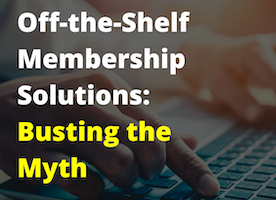Let’s start off with what you probably already know: Off the Shelf Membership Solutions software is a pre-built solution with features and functionality that’s ready to go, while bespoke software is custom-built to meet an organisation’s specific needs. With bespoke software, you’re in control of everything: the features, what tasks you can perform, the integrations and even the look and feel of the system.
One thing to make clear from the very start of this best: a one-size-fits-all software solution to all the challenges faced by membership bodies simply doesn’t exist.
We often apply the Pareto Principle into our way of thinking. It’s the idea that 20% of effort makes up 80% of cause. (20% of your customers make up 80% of your business, for example).
With this idea in mind, we usually find that organisations who opt for off-the-shelf software spend 80% of their cost customising it to suit their needs.
After they’ve paid to purchase the software and then waste time tweaking it to make it right, they would have been in the same position building their own unique platform from the outset.
Not to mention that off the shelf software can be complicated to customise because it was made to be used out of the box and doesn’t provide much flexibility or scalability.
Times Off the Shelf Fits the Brief
There are times when an out of the box membership management solution will do the job. Some membership organisations that require general functions find these are good options because they provide a wide range of features such as member management, event management, communication tools, and online payment processing.
The issue is when they need to perform more task than that or they need it to integrate and pass information with other systems.
This is when you start having to throw money, time and resource at it to make the system perform the extra tasks and integrations you want it to.
What You Get from Going Bespoke
Custom software can be tailored to the unique needs of the organisation and can often provide greater flexibility and scalability than off-the-shelf software.
A membership association may choose to go down the bespoke development route for a variety of reasons, these include:
- Specific Needs
If you have complex or unique membership structures, such as different membership tiers or levels. This may require custom software solutions to help you manage these structures effectively.
- Integration With Existing Systems
A membership organisation may already have existing software systems in place (including accounting or events management) which need to be integrated with the membership management system. Custom software can be tweaked to integrate seamlessly with these existing systems.
- Scalability
Off the shelf software may not be able to scale effectively to meet the changing needs of a growing membership organisation. custom software, when done properly, is built with growth in mind. This means it’s quick and affordable for the organisation to add new features or functionality as and when it is needed in the future.
- Competitive Advantage
As a membership body, you want to stand out in your industry and be the go-to place for professionals in your sector. One of the ways to achieve this is providing your members with unique features and a more user-friendly experience.
- Cost-Effectiveness
Yes, custom software may require a higher upfront cost, but it can provide long-term savings across multiple areas, including reduced manual effort, streamlined processes and running/maintenance costs on the system.
What’s The Better Option For You?
Ultimately, opting for custom software allows a membership organisation to have greater control over the functionality and features of their membership management system. While an off the shelf solution can be a good option if you have relatively straightforward membership structures and needs, it’s important to carefully evaluate the limitations you may encounter from purchasing a system that was built to carry out only specific functions.
Always ask: Does this meet the specific needs of my organisation? If it doesn’t, how much time and cost would it take to adapt it? By answering those questions, you will have a clearer idea as to whether off the shelf is a better option for your membership association is. It will also allow you to assess the value of the project and return on investment.
PSP has 15+ years experience designing and developing bespoke computer systems. We flip the Pareto Principle and say the development stage only makes up 20% of a development project. We put equal time and resource into the requirements gathering, planning, solution finding and testing stages as we do with the development phase. This results in an effective software development lifecycle and ensures all the client’s requirements are met.










Leave A Comment